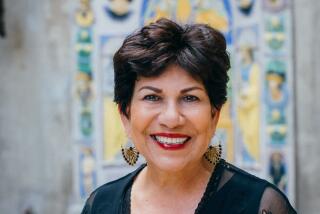Ricardo Favela, 62; helped create Chicano art group, was longtime professor
- Share via
Ricardo Favela, a founder of the Royal Chicano Air Force, a group of Mexican American artists who used poster art to support Chicano civil rights causes, has died. He was 62.
Favela, who was on the faculty of the art department at Sacramento State, died of a heart attack July 15 in Visalia, Calif., his daughter Florentina said. A resident of Sacramento, he had attended a family party in Visalia and died in his sleep later that night.
Favela was best known for his silk-screen posters that announced political rallies, community projects and art events. He often used skeleton figures in his work in the tradition of Mexican folk art.
“Social commentary was the point of Ricardo’s art,” said Catherine Turrill, chairwoman of the Sacramento State art department, in an interview this week. For the Royal Chicano Air Force, she said, “art was an instrument of social change.”
Favela was known on campus as a mentor whose office was a center of student activity and a haven for students from migrant worker families. They found an understanding listener in Favela, who was also the son of migrant workers.
He encouraged a number of his art students by exhibiting their work beside his in gallery shows at the university.
“Mentoring was a big part of Ricardo’s nature and his artistic tradition,” Turrill said. “His students became part of his family.”
Favela found his direction as an artist while he was an undergraduate at Sacramento State in the late 1960s. He and several other Latinos in his class joined their professors, Esteban Villa and Jose Montoya, to form the Rebel Chicano Art Front in 1969.
They used the abbreviation RCAF, but it confused some people, who thought the letters stood for the Royal Canadian Air Force. The artists then changed their name to the Royal Chicano Air Force, a play on the misunderstanding.
The mix-up became part of their identity. When the Royal Chicanos appeared as a group, they dressed in flight jackets, aviator glasses, vintage helmets and other military garb, traveling together by jeep.
Favela and his colleagues worked together on murals in cities around the state. Those artworks included more than a dozen murals they painted on public walls in Sacramento.
They also founded community service programs, among them the Nueva Raza bookstore and the Barrio Art Program for underprivileged children in Sacramento.
Individually the artists made posters to support Sacramento-area concerts and art shows as well as Latino causes, particularly the farmworker movement.
“Ricardo brought his sense of humor to the group,” said Montoya, who credits Favela with encouraging the members to play off the Air Force idea when they changed their name.
As a teacher, he inspired students to get involved in community issues. Several of them worked with him in the Barrio Art Program.
“Empowering youth through education was very important to Ricardo,” said Xico Gonzalez, a former student of Favela.
“He taught his students to be proud of their cultural roots and keep their culture alive in their art,” Gonzalez said. “Ricardo would say to all of his students, ‘Everybody has a cultural background. Use it in your art.’ ”
Favela was born Jan. 19, 1945, in Kingsburg, southeast of Fresno, and raised in nearby Dinuba.
He saw enough of field work as a child to know that he wanted a different life, his daughter said.
After graduating from high school he earned an associate’s degree from the College of the Sequoias in Visalia. He then enrolled at Sacramento State, where he earned a bachelor’s degree in 1971 and a master’s degree in 1989.
He taught part time at Sacramento State as a graduate student and joined the faculty as a full-time professor in 1997.
He recently donated his collection of posters, prints and other artworks by the Royal Chicano Art Force collective to the library at UC Santa Barbara.
In addition to Florentina, Favela is survived by his wife, Clara; daughters Margarita and Rosita; sons Florenzio and Manuel; three sisters; two brothers; and numerous nieces and nephews.
Funeral services were held in Dinuba.
--
More to Read
Sign up for Essential California
The most important California stories and recommendations in your inbox every morning.
You may occasionally receive promotional content from the Los Angeles Times.













